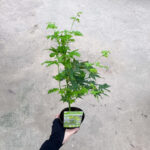The Beauty of Maple Trees: A Guide to Planting and Caring for Maple Trees
What do you mean by Maple Tree Plant?
Maple trees are iconic trees known for their vibrant and colorful foliage, making them a popular choice for landscaping and adding beauty to outdoor spaces. These trees belong to the genus Acer and are known for their distinctive leaves, which often have a unique shape and color. Maple trees are prized for their ability to provide shade, shelter, and beauty to any yard or garden.
How to Plant a Maple Tree?

Planting a maple tree is a relatively simple process that can be done in the spring or fall. Start by choosing a location with well-drained soil and full sun to partial shade. Dig a hole that is twice as wide and slightly shallower than the root ball of the tree. Place the tree in the hole, making sure the top of the root ball is level with the ground. Backfill the hole with soil and water the tree thoroughly to help settle the soil.
What is known about Maple Trees?
Maple trees are known for their striking foliage, which changes color in the fall to vibrant shades of red, orange, and yellow. They are also known for their sap, which can be harvested to make maple syrup. Maple trees are common in North America, Europe, and Asia, and there are over 128 species of maple trees worldwide. These trees are typically hardy and can withstand a variety of climates and soil conditions.
Solution for Maple Tree Plant Health
To keep your maple tree healthy and thriving, make sure to water it regularly, especially during dry periods. Mulch around the base of the tree to help retain moisture and prevent weeds from growing. Prune the tree occasionally to remove dead or damaged branches and promote new growth. Fertilize the tree in the spring to provide it with essential nutrients. Monitor the tree for signs of pests or diseases and take prompt action to address any issues.
Information about Maple Trees
Maple trees are deciduous trees, meaning they shed their leaves in the fall and grow new ones in the spring. They are typically medium to large in size, with some species reaching heights of over 100 feet. Maple trees have shallow root systems, so be careful not to disturb the roots when planting or landscaping around the tree. These trees are also popular for their wood, which is used in furniture making, flooring, and other woodworking projects.
How to Care for Maple Trees
Caring for a maple tree involves regular watering, mulching, pruning, and fertilizing. Make sure to water the tree deeply and infrequently to encourage deep root growth. Mulch around the base of the tree with organic mulch to help retain moisture and regulate soil temperature. Prune the tree in the late winter or early spring to remove dead or damaged branches and shape the tree. Fertilize the tree in the spring with a balanced fertilizer to promote healthy growth and development.
Benefits of Maple Trees
Maple trees offer a variety of benefits to the environment and to homeowners. They provide shade and shelter for wildlife, reduce air pollution, and improve soil health. Maple trees also add beauty and value to any property, making them a popular choice for landscaping. These trees are relatively low maintenance and can thrive in a variety of climates and soil conditions, making them a versatile and attractive option for any yard or garden.
Growing Maple Trees from Seeds
If you want to grow a maple tree from seeds, start by collecting mature seeds from a healthy tree in the fall. Store the seeds in a cool, dry place until the spring. Stratify the seeds by placing them in a moist paper towel in the refrigerator for several weeks. Plant the seeds in a pot with well-drained soil and keep them moist until they germinate. Transplant the seedlings into the ground once they have developed several sets of true leaves.
Conclusion
Maple trees are not only beautiful additions to any yard or garden but also offer a range of benefits to the environment and to homeowners. By following proper planting and care techniques, you can enjoy the beauty and shade of a maple tree for years to come. Consider planting a maple tree in your outdoor space to add color, value, and natural beauty.
FAQs
1. Can maple trees grow in all climates?
Maple trees are versatile and can thrive in a variety of climates, but some species are better suited to certain regions.
2. How often should I water my maple tree?
Water your maple tree deeply and infrequently, allowing the soil to dry out slightly between waterings.
3. When is the best time to prune a maple tree?
Prune your maple tree in the late winter or early spring before new growth begins.
4. Are maple trees susceptible to pests and diseases?
Maple trees can be affected by pests and diseases, so monitor your tree regularly and take action to address any issues.
5. Can I tap my maple tree for sap to make maple syrup?
Yes, some species of maple trees can be tapped for sap to make maple syrup, typically in late winter or early spring.
